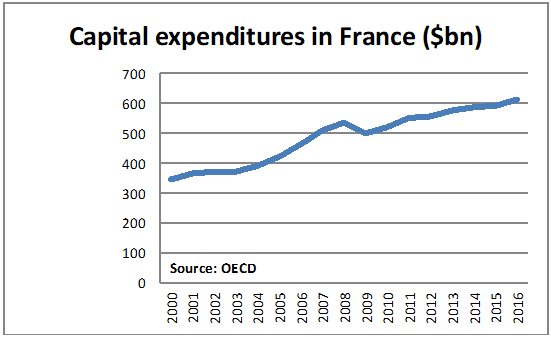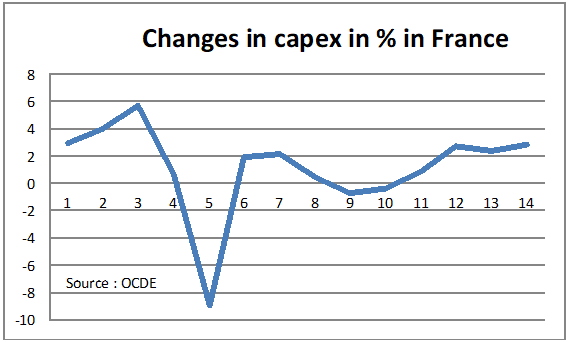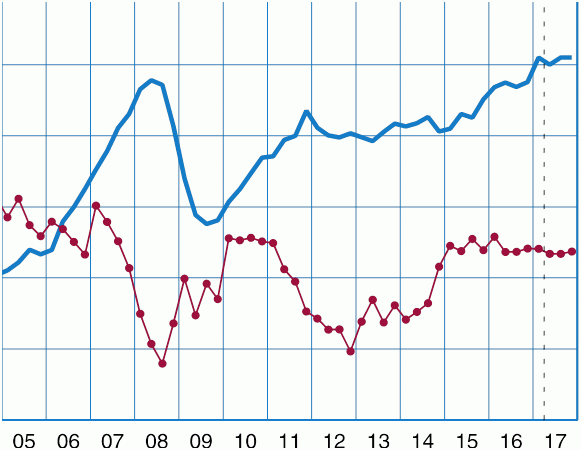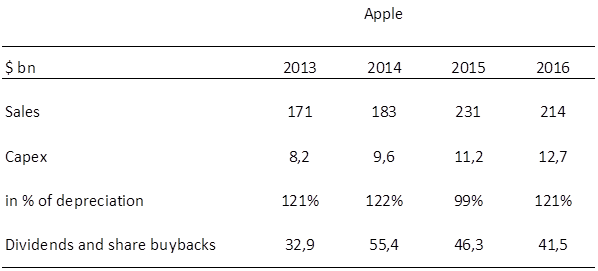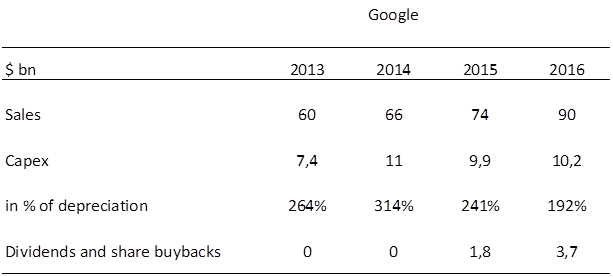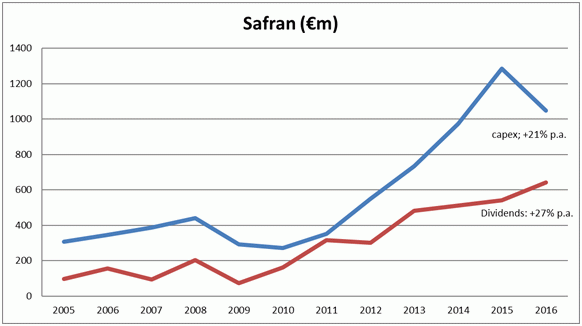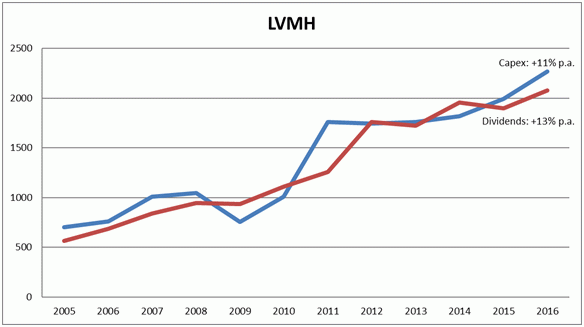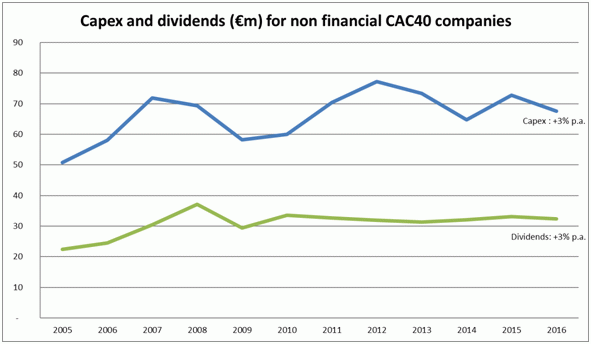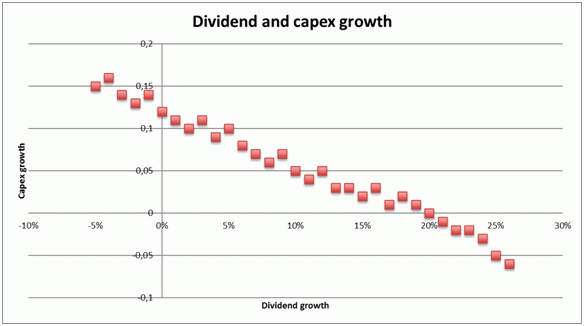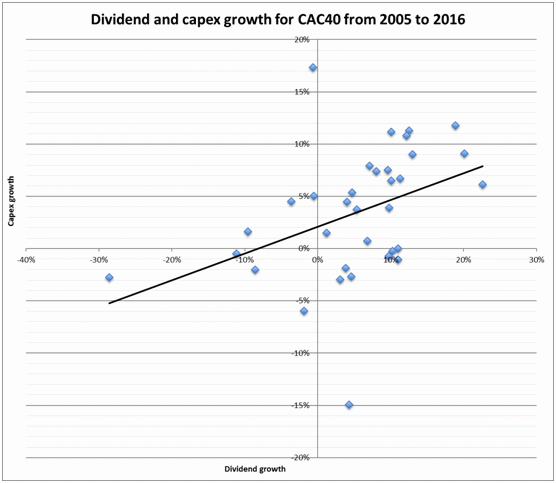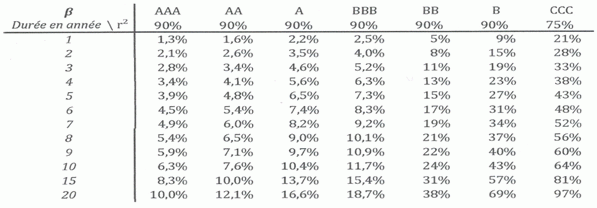Letter number 109 of January 2018
- TOPIC
- STATISTICS
- RESEARCH
- QUESTIONS & COMMENTS
- NEW
News : Are capital expenditures and dividends mutually exclusive?
Regularly journalists ask us: “But if companies paid out less in dividends, wouldn’t they be able to invest more?” and the underlying assumption, create more jobs
We think that this question, often asked as though it’s an obvious statement, is a sophism, i.e. a false line of reasoning that appears to be true. The purpose of this article is to demonstrate this.
Let’s start by recalling three facts:
First fact: the dividend is often the object of fantasy and a monumental mistake. It is not the remuneration of the shareholder, but the liquefaction of part of the shareholder’s assets.
A comparison is often made equating the shareholder’s dividend and the employee’s salary. Nothing could be further from the truth. When your salary is paid into your bank account, you are wealthier by that amount. When the dividend is paid into a shareholder’s bank account, the shareholder is not wealthier by the amount of the dividend, because at the same time, the value of the share has fallen by the amount of the dividend paid. The shareholder’s assets remain the same, e.g. 100, simply instead of having 100 in shares, he or she now has 98 in shares and 2 in cash[1]. Whereas if you had had 100 in assets before receiving your salary of 2, once you receive it, your assets rise to 102.
Second fact: Investing is not a patriotic duty. Companies invest because they believe, rightly or wrongly, that there is or there will be a demand for their products or services and that they will be able to cover the cost of the capital used to make the investments. In other words that in time, ROCE will cover the cost of capital.
But profitability is not a diktat, it is a key for allocating a scarce resource – savings. In the past, other keys for distributing wealth were tested without great success, such as central planning in the USSR and in China under Mao. Other experiments are currently under way in Venezuela and North Korea.
But there are limits to investment. Overinvestment is a waste of scarce resources that are poorly allocated and that would have been better used in another company or in another sector.
Third fact: In mature countries such as in Europe and North America, investing is taking the form of the traditional purchase of fixed assets less and less. Who’s looking to construct new motorways, EPR reactors or steel plants these days? Investing is increasingly taking an immaterial form which generally goes directly onto the income statement (e.g. salaries of successful start-up’s staff). And it goes without saying that the development of the sharing economy (AirBnB, car-sharing, driverless cars in time) will boost this trend.
A sophism
Like all sophisms, the statement “paying more dividends means reducing investments by as much” at first strikes one as true. Effectively, in a company, at a given moment t, money exists in a finite quantity and allocating more to one line item means allocating less to another, at least at constant level of debt and constant perimeter and without a capital increase of course.
But this microeconomic truth at t is false on a macroeconomic level.
If not, how do you explain that in France for example, investments are currently higher and so are dividends and share buybacks, whether we reason in:
-
absolute amount:
-
trend:
-
relative amount as a % of value added, top blue curve:
Source: INSEE, Conjoncture française, Investissements des entreprises et stocks, June2017
Why this sophism?
First reason: it is not systematically the same groups that pay dividends and the same groups that make investments.
Here is an emblematic illustration, taking as an example the largest two market caps worldwide: Apple and Google.
Apple used to be a growing company but this is no longer the case, with a 7% drop in sales in the last financial year, even though it continues to invest as shown by an average investments/depreciation ratio of 115%:
Given the (temporary?) end of its growth period, Apple is returning cash to its shareholders that it no longer needs to use within the group: $176bn over the last 4 years.
Google for its part continues to grow, and even its growth rate is growing: +10% in 2014, +12% in 2015 and + 22% in 2016.
Logically, its investments represent 250% of its depreciation. Consequently, share buybacks and dividends are microscopic (relatively speaking that is): $5.2bn since 2013.
And in France?
We took a look at what was happening at the top 40 listed companies (CAC 40) excluding banks and insurance companies, i.e. 34 groups, between 2005 and 2016. Why take 2005 as a starting point? Because this is an average point in the stock market cycle between the low point of 2003 and the high point of 2007, a bit like 2016.
In the top quartile, only 4 of the top 9 dividend payers are also among the top 9 big investors (Total, Orange, Engie and ArcelorMittal).
Sanofi, Vivendi, LVMH, L’Oréal and Danone are among the top 9 dividend payers but not among the top 9 investors.
Conversely, Airbus, Carrefour, Véolia, Renault and Peugeot are among the top 9 investors, without being among the top 9 dividend payers.
But paying large dividends does not prevent a company from making major investments, since the 9 biggest dividends payers (66% of dividends paid) make 59% of investments.
Let’s not forget that the dividend is the best way of reallocating the capital of mature companies that no longer need it, and that generate more than they can use without overinvesting, to companies that need it today and that, sooner or later, will be their successors.
IBM, which was the Google of the 1960s-1970s, and whose sales have been declining since 2008, has thus become a payer of very large dividends/share buybacks.
Dividends and share buybacks are anti-status quo tools.
Only conservatives don’t like dividends and share buybacks. Real progressives (and not pretend progressives) are keen on them because they ensure that money circulates, they shake up the status quo and enable new players to finance their operations more easily!
Second reason: We’ve forgotten how dynamic flows were within companies in the past.
Keeping a dividend per share constant over a few years can make it possible to make more investments which could make it possible to pay more dividends later. Let’s take a look at Safran whose dividends remained stable between 2005 and 2009. We might have assumed that with dividends increasing by 27% per year since 2009, investments would have had to be sacrificed. This was not the case at all – they rose by 21% per year!
We can also look at LVMH, which went from the No. 9 French market capitalisation in 2005 to the No. 1 today. It’s the same story, strong growth of both dividends and investments:
And if we look at the level of the CAC 40 excluding financial companies, here too we see parallel curves, demonstrating that dividends and investments are not mutually exclusive:
If paying more dividends leads to lower investment, we should see an inverse correlation over time: the higher the growth rate of dividends, the lower the growth rate of investments would be (possibly even negative growth) which would look like this:
Each point corresponds to a company.
However, on the CAC 40, exactly the opposite has been observed since 2005:
* * *
So it’s high time that we forget that poorly drafted Marxist vulgate which is quite simply wrong, as demonstrated by the facts. Investments and dividends are not antithetical and mutually exclusive. On the contrary, they often go together.
[1] For further details see the chapter 36 of the Vernimmen
Statistics : Bond betas
Rarely used, because it often does not differ significantly from zero, the beta of corporate debt measures a company’s volatility compared with that of the market, in the same way as equity
beta measures the volatility of shares compared with that of the market.
The beta of debts is used to determine unleveraged beta when calculating the cost of capital using the direct method[1]. As shown in the table below, drawn up by Roland Clère and Stéphane Marande[2], bond betas can be considered as negligible when the company is rated at least BBB (investment grade), for an average debt period of up to 8 years. Beyond this period, and above this rating, the bond beta exceeds 0.1 and is no longer negligible. But, it is rare for a company to have total net bank and financial debt for a period of more than 8 years, and explicit or implicit BB or lower ratings are not infrequent, especially for very small or small- to medium-sized enterprises.
[1] For more on its use, see chapter 29 of the Vernimmen.
[2] In the article “Risk of default and value of shares: A cultural revolution?” available on www.ssrn.com.
Research : Directors that are truly independent?
With Simon Gueguen, Senior Lecturer at the University of Cergy-Pontoise
The presence of independent directors on a board of directors is often considered as being a good thing for corporate governance. In companies with a dispersed share capital, their role is to protect the interests of shareholders vis-à-vis management and in companies controlled by a majority shareholder, their role is to protect the interests of minority shareholders. But are they really independent? In an article published in the renowned Law Review[1], Professors Bebchuk and Hamdani question the efficiency of appointment procedures in the US and elsewhere, and come up with suggestions for improvements.
Bebchuck and Hamdani focus specifically on companies controlled by a majority shareholder. The problem stems from the fact that “independent” directors owe their appointment and reappointment mainly to the majority shareholder. They suggest submitting the appointment of some of the directors to the vote of minority shareholders only. The latter could, even though they can’t choose the independent directors directly, at least have a veto right over their appointment and reappointment. Bebchuck and Hamdani take the recapitalisation plan adopted by Google in 2012 as an example. This involved an issue of shares without voting rights that would result in an increase in the capital without reducing the majority shareholders’ control. For this purpose, Google set up a committee of independent directors tasked with negotiating the terms of the transaction. Bebchuk and Hamdani’s suggestion would probably have made it possible to raise doubts about the real independence of the said committee and thus about the transaction itself.
The question, however, remains a complex one. The position of a majority shareholder vis-à-vis the minority shareholders is not that of a manager vis-à-vis a sparsely populated shareholding. In the latter case, the standard problem of free riding is summed up by the fact that it is not in the interests of any shareholder to control management. Pressure exercised by shareholders then involves threatening to sell their shares, although this market mechanism is generally insufficient. Better protection of shareholders is necessary to enable the company to finance its operations in the best conditions. The case of majority shareholders is different. The latter are by definition heavily invested in the company and it is in their interests to create value. Their possibility of steering the company’s strategy in their favour, and even capturing private profits to the detriment of minority shareholders, is partly justified by the fact that they bear most of the costs of governance. Bebchuk and Hamdani suggest that directors appointed by minority shareholders only play a significant role in matters that present a risk for minority shareholders (as in the Google case), maintaining majority shareholder control for other decisions.
Another recent article on the subject provides food for thought[2]. It is an attempt at modelling the directors market. The article shows that a director that is truly independent from management is only compensated if the other companies have put in place good governance practices. Accordingly, there are externalities in the governance of companies: the presence of independent directors in a company will tend to spread to other companies, and the issue of their real independence will then be all the more crucial.
Bebchuk and Hamdani’s suggestion has moved discussions on independent directors forward but it has its limitations. There are numerous ways in which majority shareholders can capture profits to the detriment of minority shareholders. The aim of protecting minority shareholders without altering the control of majority shareholders is difficult to achieve, and the main issue, that of the optimal degree of protection for minority shareholders, remains open.
[1] L.A.BEBCHUCK and A.HAMDANI (2017), Independent directors and controlling shareholders, University of Pennsylvania Law Review, vol. 165(6), pages 1271 to 1315
[2] D.LEVIT and N.MALENKO (2016), The labor market for directors and externalities in corporate governance, Journal of Finance, vol. 71(2), pages 775 to 808.
Q&A : Is assessing economic activities based on their profitability in the best general interest?
In the economy, there are two types of companies, in the broad sense of the word.
Firstly, there are companies that benefit from financial resources the cost of which is not invoiced to them. These include charities, NGOs, some public companies as they receive subsidies, contributions, donations, etc., in sunk costs. Those who grant them these funds are not expecting any kind of financial return, although they are expecting returns of another sort, since finance isn’t the only thing in life.
Secondly, there are companies that benefit from resources the cost of which is invoiced to them in one way or another, in the form of interest, dividends or the hope of capital gains.
The two types of companies coexist in the economy, have different roles and it cannot be said that one is going to take over from the other or that one is going to disappear and the other not.
Factually, the second category has for a long time accounted for the largest number of jobs, the largest share of value added and the largest share of innovations.
A company in the second category has to find financial resources that enable it to finance its investments in the broad meaning of the term such as a change in working capital, hedging of start-up losses, investment in an R&D programme, construction of a new factory, acquisition of a distribution network, etc.
But those who provide the funds, the investors, whether they are lenders, bankers or shareholders, do not do so without requiring a minimum rate of return that is in line with the risk incurred. There’s a simple reason for this. It is always more pleasant to spend €100 this evening on dinner for two than to save the €100 and get back, whether in one year or in 10 years, the same €100 without any interest. With a zero interest rate, the vast majority of people would consume immediately without saving any money for more than a few days. This is what is known as the preference for the present and is a human trait that has been well-established for thousands of years and across continents. Accordingly, the interest rate is fundamentally, for the individual, merely compensation for renouncing immediate consumption in favour of future, hopefully greater, consumption. For society, this is what makes it possible to create surpluses which in turn make it possible to invest in the future which is what makes progress possible.
So, those who finance companies of the second type are expecting a rate of return on their investments and if they didn’t get one, they wouldn’t invest. This doesn’t prevent them from simultaneously financing companies of the first type. Take the example of Warren Buffet, one of the most talented investors of our era and also one of the greatest philanthropists of all time. But he can only be so philanthropic because, having stared out with nothing, his financings of companies of the second type were so wisely chosen, that he now has the resources that he didn’t have at the outset.
In the same way that a company acquires raw materials by paying for them and that it benefits from human resources for the time during which they produce physical or intellectual work by paying them, it obtains financial resources from investors by paying them (the interest rate is the cost of money, just like the wage is the cost of work).
In the same way that a company, as a human entity, cannot survive if it is unable, over time, to sell its goods and services at a higher price than their cost price, so a company cannot survive if it is unable, over time, to earn a rate of return on its assets that is at least equal to the cost of the financial resources that it has requested and obtained. This is merely one of the dictates of finance and a condition for survival. If a company fails to pay its employees, they will leave, which is quite understandable. The same applies to investors.
Like all production factors, capital has a cost because there are not unlimited, infinite quantities thereof. But, on the other side, humans have, throughout the ages, had far more projects than financial resources (i.e. accumulated surpluses) to achieve them all at the same time – to continue the fight to get rid of world hunger and illiteracy, to find a cure for cancer and Alzheimer’s disease, to conquer Mars, reduce pollution, etc.
So, choices have to be made and to make these choices, we need tools. Over time, two major families of tools have been tested:
1. Acts of government, for example the construction of the pyramids in Egypt or more recently the work of Chairman Mao (who was keen for every Chinese commune to have its own mini-steelworks, which meant that tens of millions of people died of famine because of a bad investment choice / allocation of resources, when what was needed was investment in agricultural production and economies of scale with a small number of large steelworks), without mentioning the current North Korean dictator. Whether government takes the form of one individual or a small clique that has confiscated power and seeks to hold onto it by force or terror makes no difference at all.
2. Decentralisation and getting individuals who save to take responsibility. Because they are trained, they will try to make the best investment choices possible based on the risks they are prepared to take and the rates of return they are hoping for. Over time, these individuals have developed tools to help them make investment choices, which have been refined and are today taught in universities and business schools.
These tools were mostly developed in Europe at the start of the industrial revolution, at a time when the standard of living in China was the same as in Europe, i.e. one out of every two European citizens died before the age of 20 and very few reached the age of 50, at a time when episodic famines were on the wane. China did not adopt these tools. It began a long relative decline, which became an absolute decline from 1949, from which it only emerged around 40 years ago when it got rid of the Gang of Four and started to trust individuals.
As far as we’re concerned, we have absolutely no desire to return to the “acts of government” tool when it comes to making investment choices. And nothing leads us to believe that the millions of Chinese, Ethiopians and Indians, who over the last 40 years have emerged from absolute poverty, are at all envious of the people of North Korea, Venezuela or Cuba. In any event, we don’t see them queueing up to immigrate to these “paradises”.
Do these tools impose the pre-eminence of finance within the company? No, as we explain in chapters 1 and 26 of the Vernimmen, the financial director is there to enlighten general management, the latter is perfectly entitled to choose investments based on other criteria, but only if the returns on the latter are insufficient, other investments made or to be made will have to make up for these insufficient returns to cover the cost of the funds generated to make these investments. Failing this, the company will have serious difficulties in continuing to access financial resources, if it is not able to meet the requirements in terms of returns of the investors that provide it with funds. Just as in the same way that if we were to spend more than we earned, unless we had inherited money or saved up, we would also have serious problems.
Can these tools factor in the negative externalities generated by the company? Yes technically, but public authorities will have to measure them and get the company to pay for them, because by construction, it is not the company that is in a position to measure is negative impact on the local environment. When a tax was introduced on supermarket flyers that used to fill our letter boxes, calculations of company’s returns were adjusted and they soon phased out this practice, the cost of which now exceeded returns. The introduction of carbon credits has had similar effects on a sector that is not as frivolous as the previous one. This is a question of democracy, i.e. the ability of the majority of citizens to convince politicians to penalise the creators of negative externalities deemed collectively to be undesirable and to help those who will suffer as a result of restrictions introduced (the coal miners whose mine will be closed before it is mined out). We’ve got a long way off the subject of the technical area of the financial management of companies.
Are these tools a guarantee that the right choices will always be made? No. But since we haven’t, for the moment, found a better way, we have to make do, as we made do with the horse before rail transportation was invented. And when somebody does come up with something better, you can count on us to publish it in the Vernimmen post-haste.
New : COMMENTS
Regularly on the Vernimmen.com Facebook page[1] we publish comments on financial news that we deem to be of interest. Here are some of the comments published over the last month.
There are no miracles in finance.
Total had announced that it would continue to pay the same dividend per share despite lower earnings and free cash flows due to falling oil prices. The oil group had succeeded in doing so by proposing to its shareholders to receive their dividend, at their discretion, in Total shares issued with a discount of 5% on the share price or in cash. Every quarter, nearly two-thirds of its shareholders opted for the dividend in Total shares, because pocketing a 5% discount is not something most investors refuse. Those in need of cash resale the shares thus obtained. And Total has thus saved in cash for quarters almost two thirds of its dividend. For the first time at the end of 2017, Total offered to pay its quarterly dividend in cash or in Total shares, but without the 5% discount. Guess what? Total has just indicated that the proportion of shareholders who, in these circumstances, opted for the scrip dividend has fallen to 21%. Shareholders know how to count. . .
If the price of a barrel does not relapse, it is likely that the next step for Total will be to pay a dividend entirely in cash.
You may be wondering why Total had to use this scheme to post a constant dividend per share, but paid for a very significant portion in shares issued with a discount on prices, rather than lowering its dividend and paying it in cash only to the level of free cash flow generated after oil price decline. The answer is that in the small world of super majors oil companies, 4 Anglo-Saxon and Total, shareholders, often Anglo-Saxon pension funds, are there to receive dividends that will allow them to pay regular pensions to their pensioners. Any decline in the facial dividend would have been ill taken, breaking the bond of trust that dates back to 1981, the last time Total lowered its dividend. In the same vein Shell's CEO (Ben van Beurden) declared: "The dividend is a sacred element at Shell, I will do everything to protect it" and he used the same trick as Total to maintain constant its dividend per share despite a collapse of 60% in the oil price.
All this may seem artificial to you, but who would have told you that behavioral finance did not exist?
An example of market efficiency
The reaction of Intel's stock price and that of its competitors the day before yesterday is an excellent illustration of the theory of portfolio and that of efficient markets. When Intel's share price declines by more than 5% in response to product security concerns, its rivals rise at the same time as investors immediately anticipate that Intel customers will switch suppliers. Not putting all your eggs in one basket for those who want to limit the specific risk of a share is not a bad (or recent) idea!
Mergers and acquisitions in 2017.
4th year of the high cycle phase of this highly cyclical activity and highly correlated with stock market indices (see the first graph of chapter 44 of Vernimmen, which goes back to 1986). The United States are still impressive with a volume of transactions almost double those in Europe ($1635bn against $861bn) when their GDP is only 10% higher. Happy American M&A bankers who benefit in addition of a lower level of competition compared to Europe. Asia again in front of Europe ($939bn) for the third year in a row.
Liquidity issue
While visiting the temporary exhibition at the Jacquemart-André museum in Paris, dedicated to the Hansen Collection of French paintings, you may wonder why Wilhelm Hansen had to sell half of his collection in 1922 because of the bankruptcy of his bank, Danish Landmansbank. Indeed, the causal link is not obvious. In fact, the bankruptcy of the lender does not directly concern the borrower, who remains of course debtor of his debt, except for the cash he may have entrusted to him.
In fact, along with other collectors and art dealers, Wilhelm Hansen had formed a consortium able to buy entire collections of paintings to keep the ones they were interested in and sell the others. To finance themselves, they had been indebted, in the short term to the Landmansbank, which regularly renewed the loan while it was in activity. When it went bankrupt, its liquidator demanded, of course, repayment of the short-term credit when it was due. And since the guarantee (the paintings) were not particularly liquid (oils as well as pastels), Hansen and his associates, who held to their honor, sold the paintings rather than defaulting.
All this could have been avoided if they had run into long term debt. The problem is that banks at that time only lent in the short term because they had only short-term resources. The banking transformation was still in its infancy.
American tax reform
We will comment 3 points:
1 / The United States becomes the 3rd largest country to limit the tax deductibility of financial expenses. After France which limits the deductibility of financial expenses greater than €3m to 75% of their amount, the United States joins Germany by refusing tax deductibility for financial expenses that exceed 30% of EBITDA. From a financial point of view, there is no reason for the state to encourage a specific tax reduction (the deductibility of financial charges) for companies to prefer a source of financing (indebtedness) to the detriment of another (equity), especially when excessive indebtedness generally increases business difficulties. For more details, see The Vernimmen.com Newsletter n° 62, November 2011.
2 / The United States abandons their worldwide tax system for corporate income tax that taxes foreign affiliates of US groups on their profits made abroad when they were repatriated to the United States in the form of dividends, which are then taxed for the difference between the US 35% rate and the local rate. As the US 35% rate was one of the highest in the world (see The Vernimmen.com Newsletter n° 105, July 2017), the consequence of this system was the incentive not to repatriate to the United States the profits of foreign subsidiaries that are not reinvested locally and to accumulate piles of cash abroad, as famously illustrated by Apple (see The Vernimmen.com Newsletter n°75, July 2013); all while waiting for a measure of grace, as there was in the past, allowing an exceptional repatriation during a few months with a very reduced taxation. Alternatively, some US companies were being absorbed by a foreign company in order to evade the US tax system for their foreign affiliates. We have seen merger-acquisition transactions mainly explained by tax considerations, which does not seem very healthy (see The Vernimmen.com Newsletter n°83, September 2014). The lowering of the corporate tax rate from 35% to 21% of course made this global profit regime essentially ineffective since most of the world's major countries have a tax rate close to or higher than 21% (the United Kingdom and Switzerland are exceptions).
3 / The non-real estate capital expenditures of US companies become fully deductible from the base of their corporate income tax until 2022. No need to wait several years by the technique of depreciation to obtain this outcome.
